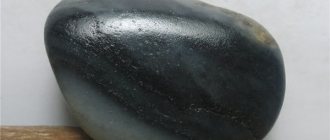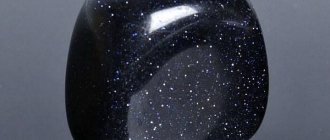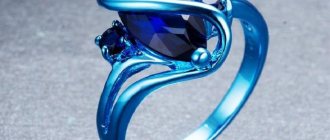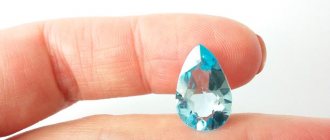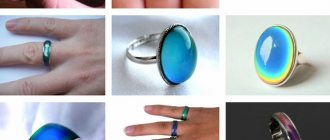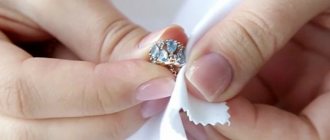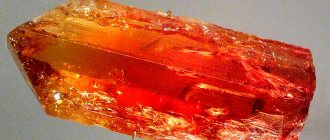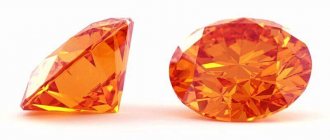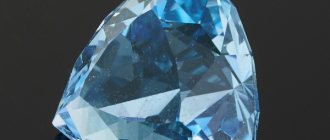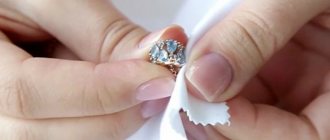Description of the stone
Precious Swiss topaz.
Swiss blue topaz is a type of gemstone that combines shades of bright blue in its facets, complemented by gray tints. The unique color and mirror-like shine distinguish this mineral from other varieties of blue topaz.
The Swiss gem, in addition to visual pleasure, will bring psychological and emotional benefits to its owner, give him confidence and attractiveness, and awaken positive thoughts in him.
The natural mineral belongs to the group of semi-precious aluminum silicates.
The precious gem has the following characteristics:
- high hardness and density;
- glass or mother-of-pearl overflows;
- absolute transparency;
- light refraction ability;
- small gray inclusions that are not a defect.
Who suits the name
Names with which topaz has a beneficial effect:
- Agatha, by nature, strives for independence. The crystal will provide support in this.
- Anastasia sometimes feels defenseless, the amulet will give her confidence and show her the path where there will be no people who can offend her.
- Maryana is too strict with herself and those around her, the mineral helps lower the level of self-criticism, teaches you to like yourself and enjoy life.
- Natalya is proactive, sometimes obsessive. With the help of a topaz amulet, paths for realization are opened.
- Larisa is characterized by excessive emotionality, which harms relationships with people around her. Topaz is an assistant in balancing the emotional state.
The gem energetically supports those who believe in the help of nature and their own strength.
Origin story
It is no coincidence that the stone received this name. Its first small deposits were discovered in the Swiss Alps. However, these reserves have long since dried up, although treasure hunters have found isolated samples of the Swiss blue mineral.
Natural blue topaz was rare and therefore expensive. In the early 1970s. Research into gemstone processing methods has shown that colorless topaz is a good material for cutting.
It is abundant, available in large crystals of high clarity, and can be processed to a uniform blue color.
Thus, 3 varieties of blue topaz were created:
- Sky Blue - a gem of a heavenly hue;
- Swiss Blue - bright blue stone;
- London Blue is a dark blue crystal.
Interesting Facts
- The largest topaz found in Brazil weighs 5,800 kg.
- The raw, wine-yellow crystal, discovered in 1965 in a mine at the Volyn deposit in Ukraine, weighs 117 kg.
- Another precious topaz, named “Akademik Fersman” and weighing 2 kg 117 g, amazes with its amazing transparency and the beauty of its internal blue glow. The place of its discovery is the Zhytomyr region (Ukraine).
- The “Fairy Tale” crystal (weighing 2 kg 200 g), discovered in the Volodarsk-Volynsky pegmatite field, has a completely transparent body and inclusions of fluorite, strikingly similar to dandelion inflorescences, making up a landscape of extraordinary beauty inside the gem. The approximate cost of the stone is 200,000 rubles.
- The colorless Braganza topaz, weighing 328g and shaped like an egg, was discovered in Brazil and valued at £57 million. Mistaken for a diamond, the stone was set into the crown of the King of Portugal.
In dream books, topaz symbolizes reliable, strong friendship. If you dream that you:
- you receive topaz as a gift - you should expect love adventures soon;
- if you buy jewelry with this stone, fate will give you acquaintance with pleasant people;
- lost a gem - in reality you should be wary of the machinations of envious people;
- you intend to take the item with topaz lying on the table, but a large dog prevents you from doing this - this means that in reality you were unable to please your superiors.
Stone deposits
In 1969, the mineral was named the “Jewel of Texas” in honor of the discovery of small deposits of pale blue topaz there. It evolved as a crystalline material in granitic rocks and lava flows.
The modern natural resources of colorless stone are located in Sri Lanka. The most common places where Swissy is harvested are Ukraine, Namibia, Australia and Japan.
Gem deposits in these countries yield a good harvest of bright blue minerals. However, the International Association of Gemologists rarely classifies them as Swiss topaz because they differ from natural Swiss ones.
Some impurities included in the stones reflect the specifics of the deposit and give them a different shade. Not a single mineral brought from other regions can compete in the beauty of blue with Swiss finds.
The value of topaz
First of all, a person starting to study minerals wants to know how to determine the value of a stone and distinguish a precious mineral. Everyone knows perfectly well that emerald, diamond, and sapphire belong to the class of precious stones, but not many people know why they became so. It is worth noting that the classification of stones arose recently - in the 19th century. Many people mistakenly believe that the list of jewelry was approved a long time ago and is no longer subject to correction. In fact, the list is updated regularly. Minerals are constantly added and removed from the list, this is due to the discovery of new rich deposits or the depletion of already known ones. Many jewelry associations note in their rules that the “semi-precious” category does not exist.
Let's figure it out: is topaz a precious or semi-precious mineral? Let's look at what we've learned. As we learned, this division appeared primarily from the number of deposits where raw topaz can be mined. There are quite a few such places, many precious stones and topazes are mined in Brazil, blue and red colors are common there, in Europe the largest deposit is in Germany, colorless, yellow and green topazes are found there. In Sri Lanka, gold and colorless gems are mined, and in Russia, topazes are found in two places: in the Urals and in Transbaikalia, in these places the minerals have many colors.
The price of a gem is determined by its color, although topaz is a semi-precious stone, the price for it can be very high. The most valuable stones are considered to be red, pinkish, light blue and dark blue. The price of such a mineral averages $500 per carat. In the case of yellow and brownish species, the cost is lower, but they are also not cheap: the price can reach three hundred dollars. The cost of jewelry can be affected not only by the color of the stone, but by the metal from which the jewelry is made. That is, gold jewelry is more expensive than silver jewelry.
In 1986, Brazilian treasure hunters found the largest officially recorded topaz, weighing almost 6 tons and 31 thousand carats. It was named after the ancient Indian city of Eldorado. One of the largest minerals is American Golden Topaz. Its weight is almost 4 kilograms, and its size reaches 23,000 carats. It is now in the National Museum of Natural History in Washington. The price of these giants is not disclosed by any specialist. There is an interesting fact that suggests that in the 60s of the 20th century, a stone weighing 117 kilograms was found somewhere in the western part of Ukraine. It was rumored to be a wine-yellow hue, but its whereabouts are currently unknown.
Mineral processing
The icy pastel blue color is created by exposing colorless topaz to radiation and then heating. Lighter shades are created by electrons; dark blue, familiar as London or Swiss blue, by exposure to neutrons.
This can take years as the high energy processes require storing the gem before it can be safely released. Scientists vary the processing procedure to produce jewels with a wide range of blues.
Swiss topaz is formed by a combination of neutron and electron processing in a linear accelerator and nuclear reactor, then heated to 200°C for 180 hours, producing vibrant blue colors. After irradiation, the product needs a cooling time of 8 months.
Many people are concerned about the safety of blue topaz due to the use of radiation. Facilities that process stones in this manner are licensed by the Nuclear Regulatory Commission.
The production of precious crystals, according to the technological maps approved by the Commission, makes Swiss topazes harmless.
Legislation requires that all irradiated stones be stored in a secure facility after processing. At the same time, they are monitored until the residual radiation decreases to a level that is safe for use in jewelry. This procedure guarantees the safety of copies.
How to choose and wear
Gold ring with topaz You need to choose a natural stone. When choosing, you should rely on the advice of astrologers. You should buy jewelry with topaz at a jewelry store.
In everyday life, it is acceptable to wear small accessories made of silver. Topaz in silver goes perfectly with business style.
You need to select stones of soft colors. A good choice is to match the mineral to the overall tone of the wardrobe.
Gold with topaz is an accessory for an evening dress. Large bright decorations are appropriate here. Experts advise against wearing topaz in combination with other stones. Women need to choose the color of the mineral in accordance with their color type:
- for blondes with blue and gray eyes, stones in light shades are suitable: blue, transparent, dark blue, pink;
- a brown-haired man with brown and green eyes will be decorated with yellow and wine gems;
- The bright, saturated colors of the mineral are closer to dark brunettes.
Varieties of shades
3 varieties of processed blue topaz became dominant:
- Swiss Blue is a bright blue topaz with a light to moderate tone and saturation. The vibrant color of Swiss blue is reminiscent of the rich hue of the Caribbean, which is close to the color of Brazilian Paraiba tourmaline. It is darker than heavenly and has a slightly "electric" tone.
- London Blue is a medium to dark blue topaz. London Blue is so deep that the slightly greenish tint is barely visible when viewed from an angle. It is exactly like tanzanite. This color is also called “inky” and “stylish”. This stone is considered the most valuable among other members of the topaz family.
- Sky Blue is the lightest, most subtle stone giving a bluish glow.
It is difficult to determine the boundary where a shade of blue ends and another begins. A simple rule of thumb applies around the world: medium blue is Swiss and dark blue is London.
Three shades of one stone.
Areas of application
For fashionistas, topaz symbolizes affordable jewelry with precious stones in this color scheme.
The meaning of the gem in astrology is to bring new life and positive energy to those who believe in a higher power.
For the Hindu religion, it is the symbol of the kalpa tree. It is considered one of the 9 sacred stones in Hinduism.
Swiss topaz is in great demand in the jewelry industry. Its extraordinary beauty attracts the attention of the fair sex from all over the world. Stones are inserted into rings, earrings, bracelets, chains made of gold and platinum.
Astrological characteristics
Having figured out what kind of Swiss Topaz stone it is, let's find out who it is most suitable for according to their zodiac sign.
The mineral is more suitable for representatives of the Water element. If possible, Pisces, Scorpios and Cancers should definitely please themselves with such a strong and beautiful talisman. Astrologers believe that this stone was literally created for Scorpios, who are very prone to hot-tempered actions and are quite restless. The energy of the mineral will calm them down and balance their emotional state.
Scorpio girls with blue or gray eyes should definitely take a closer look at jewelry with Swiss topaz. Its color will emphasize the depth and beauty of the eyes, making the image simply charming. For a man of this sign, the stone will help to reveal his inner potential and natural attractiveness. Representatives of this sign who have reached adulthood with the help of a gem will be able to find a path to self-knowledge. The mineral will help in meditation.
Physicochemical characteristics
The crystals are found in felsic igneous rocks such as rhyolite and in metamorphic rocks. In addition, topaz elements are found in pegmatite dikes and are often by-products of mining other precious minerals such as beryl.
Swiss topaz, composed of aluminum, silicon and oxygen, has a hardness rating of 8 on the Mohs scale. Its strength remains unchanged even after color enhancement procedures.
Physical and chemical properties:
- Rhombic system, rhombic-bipyramidal type of symmetry.
- The cleavage is perfect according to (001), unclear according to (101) and (011).
- The fracture ranges from stepwise to conchoidal.
- The shape of the crystals is prismatic, elongated along the C axis.
- The mineral does not melt and becomes cloudy when heated strongly.
- Swiss topaz decomposes with phosphorus salt to form a SiO2 skeleton.
- Behavior in acids: insoluble in HCl, releases a little HF in H2SO4 upon prolonged heating, dissolves in HNO3 after fusion with calcium carbonate.
- Formula - Al2 [SiO4] (F, OH)2.
- Content (in%): А2О3 (48.2-62); SiO2 (28.2-39); F 13 to 20.4; H2O up to 2.45. Impurities of iron, chromium, magnesium, titanium, and vanadium are noted.
Healing properties
The gemstone does not cause harm in any way, but has a positive effect on health problems such as:
- immune system disorder;
- stomach problems;
- liver and kidney diseases;
- diabetes;
- pain in the joints and lower back;
- obesity;
- headache;
- hysteria;
- sore throat.
Swiss topaz is worn to make one receptive to love and friendship, because it is capable of:
- improve communication and self-expression skills;
- bring peace of mind, stability of mind and balance the thyroid gland;
- strengthen existing abilities;
- unify body and mind through spiritual vibrations;
- eliminate anger, misgivings and anxiety.
Other properties of the stone:
- changes color in the presence of poisoned food or drinks;
- symbolizes honesty, clarity of feelings and deep emotional attachment;
- good for fourth and nineteenth wedding anniversaries;
- can gently heal past grievances and calm feelings, which will not allow you to get confused in false images from the past;
- popular as an amulet that protects the owner from nightmares;
- helps you overcome your own limits, gives you a chance to improve your existing skills;
- supports dreams and provides suitable opportunities;
- increases creativity and brings new ideas;
- relieves negative feelings, prevents stress;
- restores calm, brings bright colors to life, stimulates mutual understanding.
Swiss Topaz is the traditional birthstone for December.
Magical and healing properties
Nuclear bombing does not affect the magic of the stone:
- Like any blue topaz, Swiss Blue embodies high qualities: sincerity of feelings, kindness, decency. Used as a talisman against envy, slander, and energy attacks. It is worth wearing to gain inspiration, wisdom, and an optimistic attitude towards yourself and the world.
- Lithotherapists have discovered the positive effects of blue topaz on problems with the reproductive system or infection.
According to the Zodiac, Scorpios are suitable. Not needed by Pisces, Libra, Taurus.
Compatibility with zodiac signs
Topaz is associated with Jupiter, the largest planet in the solar system. It has always been considered the abode of greatness. Jupiter is the ruler of Sagittarius and Pisces.
The stone is also favorable for Aries, Cancer and Leo, Scorpio. He will protect and inspire Virgos. For Taurus and Gemini, such an amulet will not bring a favorable result, but it will not cause harm either.
According to astrological rules, Libra, Capricorn and Aquarius cannot wear this mineral all the time. You can wear jewelry to an event if it is irresponsible.
People born under the sign of Sagittarius can wear the mineral as a talisman for good luck. This is their stone.
Stone in gold and silver for Sagittarius and Pisces.
Products and jewelry with topaz
Silver earrings with Mystic Topaz The main area of application of topaz, which goes well with most precious and semi-precious stones, is jewelry.
The reason for such easy compatibility of topazes with other gems in products is not only the variety of their colors, but also the delightful appearance of the crystals, amenable to any type of cutting.
Topaz is cut taking into account their color:
- brown and pink crystals are processed in the form of stepped ovals;
- stones interspersed with fluorite or albite are given a cabochon shape;
- Yellow or blue specimens are diamond cut.
Jewelry with topaz is bracelets, signets, earrings, pendants made from heavy and large stones.
Topazes look equally organic in both gold and silver frames.
To highlight the shine of topazes set in gold, jewelers combine them with diamonds or artificial cubic zirconia.
In silver products they use stones of a similar price category: garnets, amethysts, peridots, citrines, zircons.
How to distinguish a real stone from a fake
The only sure way to determine originality is to find a certified gemologist to perform tests. Most jewelry stores have such a specialist.
So much work goes into Swiss topaz that without proper gemstone equipment it is difficult to determine its authenticity.
Several ways to visually distinguish Swiss Blue from a fake:
- original stones are inlaid with expensive metal;
- when touched, a polished, slippery surface is felt;
- the mineral cannot be easily scratched, and cheap quartz will remain damaged;
- in the rays of the sun, shades of gray are observed on the edges of the original product;
- real stone is heavy;
- the actual crystal remains cool even with prolonged contact with the body.
Similar products made from processed citrine or amethyst - varieties of quartz - act as counterfeits.
Mineral cost
Swiss Blue is a good replacement for expensive aquamarine, sapphire and tanzanite. The richer the shade of the gem, the more expensive it is. Swiss topaz is valued higher than the common blue mineral because it is less common on the market.
When the stone was first introduced, it sold for between $20 and $40 per carat. But the oversupply led to a sharp drop in wholesale prices - down to several dollars per carat. Today, Swiss crystal is found mainly in the mass market, and its price has the greatest influence on sales.
Swiss topaz is one of the most beautiful and famous members of the family. Its price varies from $6 to $15 per carat and above. Swiss Blue's main consumer markets are the USA, Asia and Europe.
Where does Swiss Blue come from?
The color variety of blue topazes is determined by the peculiarities of their occurrence. The shade is affected by impurities that make the stone luminous or dull, saturated or not very rich. Bright blue, reddish, grayish or brownish.
To add blue, various methods have been invented.
From time immemorial it was the heat treatment of stones plus the addition of blue mineral reagents. But the result could be dull, “dirty”, or the wrong color. By the 1950s, the process for obtaining Swiss Blue had been fine-tuned.
Later, they developed a technique for irradiating topazes in nuclear reactors. There were some difficulties:
- The radiation flow changed the crystal lattice of the stone. As a result, it could no longer transmit light completely.
- Besides, it was getting dark. The blue was complemented by undesirable shades. They were eliminated by heating and subsequent cooling of the samples in the oven.
- Sometimes the irradiated samples glowed. It was impossible to supply such a product to the market, so it was kept in armored safes for a year. The radiation of the stone decreased to normal levels.
But this applies to legally sold stones. Therefore, when purchasing Swiss Blue or products containing it, they carefully study the documents to confirm the authenticity and radiation safety of the product.
Storage and care
Timeless, elegant, classic shades guarantee a beautiful tone when used correctly. The radiation and heat treatment used to produce the blue color creates a powerful effect that protects the stone from fading colors.
However, the jewelry has a risk of splintering if it is handled roughly. Therefore, Swiss blue topaz should be protected from strong impacts. It is recommended to clean it with liquid dish soap and a soft toothbrush or sponge.
Steam and ultrasonic cleaning cannot be used. Products should be stored in a dark place, protected from direct sunlight. For this purpose, you can take a box with a lid in which other jewelry will not be stored.
